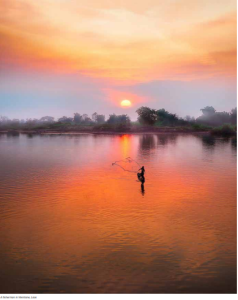
Among the various Southeast Asian states, Laos remains one of the least known and most mysterious. This mountainous, landlocked nation may have joined ASEAN for over twenty years, but its exotic beauty and rich history have remained largely undiscovered by the external world. Despite having opened for tourism since the mid-2000s, a mere 4.79 million tourists visited the country in 2019 at its peak. By comparison, over 19 million tourists visited Singapore in the same year. It is little wonder that Laos has not been visited by most Singaporeans to this day.
A BRIEF INTRODUCTION OF LAOS
Laos first became a country known as Lan Xang in 1353, when a Laotian prince named Fa Ngum returned to the country and made himself king. During the late 18th century, much of the country was taken over by the Siamese, who were later forced to withdraw from the territories they occupied when French colonists took control in 1893. The French reunited the country and named it the French protectorate of Laos. While the French briefly relinquished control of Laos to the Japanese in 1945, they soon regained control of Laos and eventually granted full independence to the country in 1953.
In terms of geography, nearly three-quarters of the country consists of highlands or uninhabitable steep forested land. The majority of the country’s population lives along the Mekong River, which winds more than 4,180km from China through Laos to the ocean in south Vietnam. The country’s capital, Vientiane, is located on the banks of the Mekong. Only 37% of the country’s population live in urban areas, with most Laotian people living in small rural communities based around the Mekong. With over 53% of the population being practising Buddhists, many of the attractions in Laos are centred around the twin pillars of Buddhism and nature.
VIENTIANE
As the capital city of Laos, Vientiane is the country’s gateway to the world. It is easy to access, with weekly direct flights from Singapore. Compared to Singapore’s bustling highrise buildings in the Central Business District, Vientiane’s distinct lack of a skyscraping skyline lends it a charming small-town feel. Most of the city’s places of interest are located near the city centre, so travelling between these spots should be very convenient.
One of the first places you may want to visit when you land in Vientiane is the Patuxai Monument, located at the end of Avenue Lane Xang in the city centre. Literally translated as “Victory Gate”, Patuxai is a well-known war memorial that is modelled after the Arc de Triomphe in Paris. It was built in the 1960s to commemorate those who fought during World War II and Laos’ independence from French rule. It was also later used to remember those who fought in the Laotian Civil War.
Designed by Laotian sculptor Tham Sayasthsena, the upper part of Patuxai is carved with Laotian ornamentations, including symbols of the Hindu Gods Vishnu, Brahma and Indra, as well as mythical creatures like the kinnaree and Erawan. At the top of Patuxai, there are five towers – four corner towers and one central tower – which represent the Five Principles of Peaceful Coexistence, as well as the Buddhist principles of “thoughtful amiability, flexibility, honesty, honour and prosperity”.
All five towers can be accessed from the third floor of the building, and they all have their own individual stairways leading up. However, the central tower is the tallest one and at the top of this tower (seven stories high), there is a viewing platform which offers a beautiful panoramic view of the city.
Another major attraction in Vientiane is Pha That Luang. Located at the end of Pha That Luang Road, this gold-leaf topped stupa is the national symbol of Laos and one of the most distinctive landmarks in Vientiane. It is a marvel to behold during daytime, with its golden pinnacle shimmering in the sun. Pha That Luang is believed to enshrine a sacred relic of Buddha, specifically the breastbone, which was brought by Buddhist missionaries from India to Laos during 3rd century BC. The monument was constructed in 1566 when Vientiane became the capital of the Lan Xang kingdom.
A high-walled cloister surrounds the stupa, with each side spanning about 85m. Many ancient Laotian and Khmer artifacts and statues can be found within the cloistered walls.
The most significant artefacts you will see in the compound are a statue of King Jayavarman VII of the Khmer Empire and a statue of King Setthathirat, King of Lan Xang Kingdom. Besides the statues, you will also find a golden reclining Buddha, a bell tower, a bodhi tree that is believed to have descended from the bodhi tree under which Buddha achieved enlightenment, and pavilions full of Buddhist art.
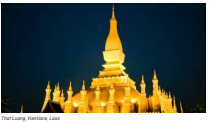
The 45m tall stupa itself is divided into three tiers, with each higher tier narrower than the one below it. The three tiers represent different places in Buddhist cosmology. The bottom tier symbolises the underworld, the middle represents the 30 perfections of Buddhist teaching, and the top tier suggests heaven or enlightenment. There are 30 smaller stupas built around the main stupa.
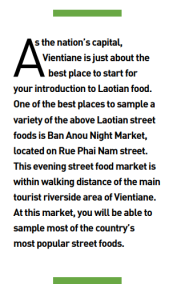
After visiting Pha That Luang, you may also want to visit two temples nearby – Wat That Luang Tai and Wat That Luang Neua. These temples were built alongside Pha That Luang. While there were originally four temples built, only Wat That Luang Tai and Wat That Luang Neua remain.
Other than Wat That Luang Tai and Wat That Luang Neua, there are a number of other prominent temples or Buddhist museums that you may want to visit during your time in Vientiane. One of the most prominent is Haw Phra Kaew, which used to hold an importance that was second only to Pha That Luang, as it was originally built in 1565 to house the Emerald Buddha. Haw Phra Kaew is now a museum of Laotian religious arts. You will see a number of Buddha statues here as well as a gilded throne for the Emerald Buddha.
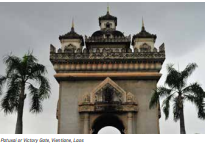
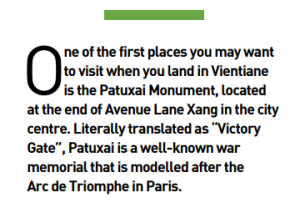
Near to Haw Phra Kaew lies another prominent temple – Wat Si Saket, the only temple in Laos that survived the Siamese occupation. One of the oldest standing temples in Laos, Wat Si Saket houses over 10,000 Buddha sculptures, including a Khmer-style stone Buddha protected by the Naga King which dates from the 13th Century. It also has a replica of the Phra Bang Statue which gave the city of Luang Prabang its name.
After visiting so many historical Buddhist temples, you may be feeling a little peckish and craving for some local food. Laotian cuisine is a delightful, well-kept secret that will surprise and satisfy you. Some of the most popular and famous Laotian street foods which you should try include Khao Niao (sticky rice that is usually served in a corn-shaped woven basket or on skewers), Laab (a spicy mixture of thinly sliced meat, fish or vegetables/tofu served with a variable combination of herbs, greens, and spices), Sai Oua (grilled pork sausage seasoned with herbs and spices), Mok Pa (steamed catfish or other white fish soaked in kaffir lime leaves, lemongrass, chilli, onion and/or fish sauce in a banana leaf), Tam Mak Hoong (papaya and vegetable salad seasoned with fish sauce, chilli, salt, sugar, and other herbs), Khao Poon and Khao Piak Sen (different Laotian noodles), Oor Lam (stew made from dried buffalo skin, beef, chicken or quail with eggplants, wood ear mushrooms, and long beans) and Ping Gai (Laotian grilled chicken marinated in soy sauce, fish sauce, oyster sauce, black pepper, sesame oil and cayenne).
As the nation’s capital, Vientiane is just about the best place to start for your introduction to Laotian food. One of the best places to sample a variety of the above Laotian street foods is Ban Anou Night Market, located on Rue Phai Nam street. This evening street food market is within walking distance of the main tourist riverside area of Vientiane. At this market, you will be able to sample most of the country’s most popular street foods. However, do note that this market predominantly caters to takeaways, and there are no tables to sit down and eat your food. Thus, you will need to either bring the food back to your hotel for consumption or settle at a place selling drinks/beer that allows you to bring in outside food.
Located some distance away from Ban Anou Night Market, Vientiane Night Market – near Sithane Road in Chao Anouvong Park – is another night market where you can sample local street fare. However, do note that the number of food vendors here is far less than that at Ban Anou Night Market, and thus, the variety of food available pales in comparison. Vientiane Night Market is more well known as a tourist market, with many stalls selling clothes and souvenirs that are targeted at travelers.
Tuk tuks (often referred to as jumbos) are one of the main forms of transport in Vientiane. However, they can be quite expensive, and you have to negotiate for your ride. Remember to haggle as drivers can charge exorbitant prices for a short ride. If you wish to take a taxi, it is better to obtain the phone number of a taxi driver from your guest house or hotel, and rent the taxi for a full day. If you are staying in central Vientiane, the good news is that most parts of the city, especially the Mekong riverside, are easily walkable.
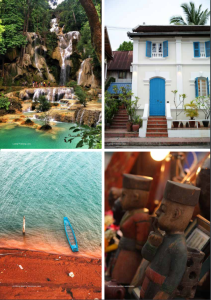
LUANG PRABANG
Luang Prabang may be a small city, but it is probably the most famous and most visited tourist attraction in Laos. Formerly the royal capital of the Lan Xang kingdom, Luang Prabang has been designated as a UNESCO World Heritage Site since 1995. This may help to explain why Luang Prabang is such a popular destination for foreign visitors. Travelling from Vientiane to Luang Prabang is a breeze as there are several modes of transport you can take. If you do not want to spend more on transport and have time to spare, you can travel by bus (including sleeper buses) or van. This could take between 10-13 hours. An alternative mode of land transport is by train, which takes about 2-3 hours. The fastest mode of transport is direct domestic flights between the two cities.
So, what are the places to visit in Luang Prabang? You cannot go wrong by starting with the many historical Buddhist temples in the city. One of the largest and most historic is Wat Xieng Thong (Xieng Tong was Luang Prabang’s ancient name). Located on an embankment above the Mekong, Wat Xieng Thong is a sight to behold with its classic Luang Prabang style architecture, which features a low sweeping double-tiered roof and a richly decorated sim (congregation hall). Built by King Setthathirath in 1559, the sim, its various chapels and other buildings make Wat Xieng Thong an architectural gem.
The temple has two entry points. One is a road entrance that features an elaborate gateway topped with a circular stupa. The other entrance is actually through the Mekong, and this used to be the main entry point in centuries past. It was the entrance that the King used when he arrived by boat from the royal palace. A long, broad stairway from the Mekong leads to the temple, where two white stone lions guard the grounds at the top of the stairs.
Within the compound, the most striking building is the sim. With intricate gold stencilled decorations adorning its exterior and interior, its sweeping multi-tiered roof as well as other beautiful drawings depicting various Buddhist elements, the building is a fine introduction to classic Luang Prabang style architecture. Other buildings that you will see in the compound include the Red Chapel which displays a rare reclining black Buddha dating back to the reign of King Setthathirath, the Tripitaka library, a drum tower, and a 12m-tall funeral carriage that contains urns for members of the royal family.
Another temple you should visit in Luang Prabang is Wat Wisunarat, the oldest temple in the city. Wat Wisunarat dates back to 1513 and is named after King Wisunarat (Visoun), who ruled Laos from 1501 to 1520. It is the oldest Buddhist temple in Luang Prabang and serves as the city’s Museum of Religious Arts. Here, you will get to see religious artefacts and precious items related to Buddhism and the royal family, including numerous centuries-old bronze and wooden Buddha statues.
Wat Wisunarat is built in the earliest Laotian temple architectural style, sometimes referred to as Luang Prabang Style I. It has a slightly different feel from some of the other temples in that it has an almost European-looking, sloping front roof covering the entrance – a simple style that diverges from the high-peaked gable or low-sweeping roofs of many other temples in Luang Prabang.
Another important and prominent feature of the temple is the unique That Pathoum (Stupa of the Great Lotus), more popularly known as That Makmo (“Watermelon Stupa”) due to its rounded dome. The dome stylistically reflects a Sinhalese influence, and is the only stupa of its kind in Laos. The stupa sets on a number of different square tiers and has a LaotianBuddhist style ushnisha crown at its top.
The Royal Palace Museum is another must-visit destination in Luang Prabang. Built in 1904 during the French colonial era for King Sisavangvong and his family, the palace – designed in French-Beaux Arts style with accents of traditional Laotian culture – was then converted into a national museum in 1995. The museum exhibits royal religious objects, weapons, statues, screens and paintings from centuries past.
The front rooms of the former royal palace, which functioned as a royal reception area, now serves as the main gallery. They are filled with busts and paintings of the Laotian monarchy, gilded and lacquered Ramayana screens, a collection of gifts from foreign states and friendship flags from China and Vietnam, as well as replicas of sculptures from the National Museum in New Delhi.
The main throne room has bright red walls, and are decorated with glass mosaics which form huge murals. Around the throne room, there are displays of ceremonial swords, Buddha statues and other artefacts of the royal family, including the thrones of the King and Queen.
Behind the throne room, the royal quarters have been faithfully preserved and offer a fascinating glimpse into the lifestyle of the royal family. This includes bedrooms of the King and Queen, a dining room, a library, and a music room displaying Laotian classical instruments and masks. There is also a building that houses the royal car collection, consisting mostly of American cars from the 1950s to 1970s. Behind the garage is another building which has a gallery for rotating exhibitions.
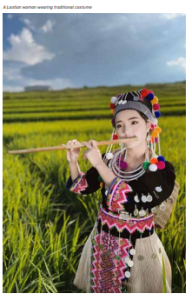
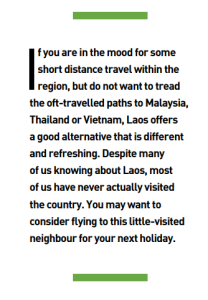
The grounds have a number of other buildings, including an exhibition hall, a chapel (Haw Prabang) and a statue of King Sisavangvong. Do note that there are a number of restrictions that you must abide by before/when you enter the premise, including a dress code where shorts and sleeveless clothing are not allowed.
If you have had your fill of historical Buddhist attractions, it may be time to indulge in the other main attraction of Laos – its nature. You can start by visiting Phousi Mountain, one of Luang Prabang’s most well-known landmarks. Located at 100m above the town, right on the confluence of the Mekong and Nam Khan rivers, Phousi Mountain offers a 360-degree view of Luang Prabang. It is a very popular spot to watch sunset, and the place can get very crowded before the sun goes down. Thus, be sure to come early to get a good position. Do note that in order to reach the top, you will need to climb over 300 stairs that will require a lot of effort. Thus, be mindful of your physical status when you attempt to go up Phousi Mountain. Also, during the Pi Mai Festival (Laotian New Year), the mountain can get very busy, with pilgrims bringing flowers, incense and other offerings to the temples and shrines along the mountain.
Another site which is a must-visit during your time in Luang Prabang is Pak Ou Caves. Lying some 25km away from Luang Prabang in a 15m cliff overlooking the Mekong, Pak Ou Caves are a two-hour boat ride away from the city. Pak Ou Caves (which consist of a lower cave called Tham Ting and an upper cave called Tham Theung) are famous for the thousands of Buddha sculptures left in the caves by pilgrims. These miniature wooden Buddha sculptures, many of them damaged, are laid out over the wall shelves. They depict many different positions of the Buddha, including meditation, teaching, walking, naga, peace, rain and reclining.
While Pak Ou Caves are essentially a religious site, it is the journey to the caves which takes the breath away. On your boat ride to the site, you will get to see a breath-taking view of the tranquil Laotian countryside, including magnificent landscapes around the caves, such as imposing limestone cliffs. On the way to Pak Ou Caves, you may also get a chance to visit the village of Ban Xang Hai, where rice wine is made, or the Khop Noi Art Gallery.
Another nature site you should visit during your time in Luang Prabang is Kuang Si Waterfall, located some 29km away from the city. You will need to engage a van or a tuk tuk to get there. This waterfall is considered to be one of the most beautiful nature sites in Laos. You will understand why this is so when you witness the serene beauty of this three-tiered cascading waterfall, which is nestled in a lush tropical jungle.
From a height of 60m, the water lands into a series of shallow pools before flowing downstream into the jungle river. After years of flowing over the rocks, the waterfall has etched deep lines into the stones, which show a beautiful travertine pattern. The picturesque juxtaposition between the crystal waters and the verdant jungle is a painterly sight to behold.
If you have the time, make a one-day trip to Kuang Si Falls to unwind in the turquoise pools. Let the water and tranquillity wash all your worries away. If you feel adventurous, you can even take a hike up to the top, where you can get a stunning, unobstructed view of the surrounding forest. Do note that the 20-minute hike involves movement through some difficult terrain.
Finally, just as in Vientiane, Luang Prabang also has its own famous night market. The Luang Prabang Night Market is located at the corner of Settathilat and Sisavangvong Roads in the town centre. From 5 p.m. onwards, the entire length of the street is closed to vehicles and the hill-tribe traders emerge with their wares, including clothes, ceramics, lamps, blankets, bed covers, handicrafts and silk scarves. If you are looking for some Laotian street food, head to the end of the market where you will find food stalls selling popular Laotian street food at affordable prices.
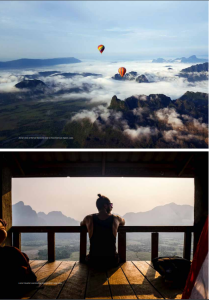
PLAIN OF JARS
The Plain of Jars is a collection of large stone jars interspersed throughout the Xieng Khouang plain in the Laos Highlands. The stone jars are mostly made of sedimentary rock, and they range from 1-3m in height. Each jar can weigh up to 14 tonnes. There are over 2,000 of these jars scattered throughout various locations in the plain. While the origin of the jars remains unknown, many archaeologists believe that they originated some 1,500-2,000 years ago, and may have been used for funeral rites or for food storage. Plain of Jars was designated as a UNESCO World Heritage Site in 2019.
It is not difficult to access Plain of Jars from either Luang Prabang or Vientiane. The site is located near to the town of Phonsavan, which has a domestic airport. While it is also possible to reach Phonsavan via bus from Luang Prabang, this is not advisable as the road trip would take around 7-8 hours.
From a distance, Plain of Jars resembles a giant chess board, with the huge jars looking like chess pieces. As you get closer, you will be able to see the fantastic mixture of jars, which were created without any fixed arrangement. Many jars protrude from the ground, while some are partially sunken. The shapes of the jars also have many different forms, including the knot, the straight mouth and the square.
There is one significant detail to note when visiting the Plain of Jars – it is actually one of the most dangerous archaeological sites on Earth. Thousands of unexploded mines remain in the area from the Secret War of the 1960s, and some of these bombs still cause injuries to this day. A number of organisations have continued to work to remove explosives from the area. At present, only seven sites are cleared for tourist visits. They are Sites 1, 2, 3, 16, 23, 25 and 52. Out of these sites, Site 1 is the most popular among tourists as it is the closest to Phonsavan, while Sites 25 and 52 are largely unvisited due to limited accessibility.
The popular Site 1 has a number of unique elements that make it a kind of a one-stop-shop of all the interesting parts of the Plain of Jars. It has the biggest jar (over 10 tonnes in weight and nearly 3m high), jars with lid, carved jars and a large cave which is thought to be an ancient crematorium. You will also see many trenches, foxholes and bomb craters – all remnants of the Secret War in the 60s. As the most popular site in Plain of Jars, you simply cannot avoid the crowds here. So, follow all the warning signs at the site to protect yourself and the many archaeological treasures
After visiting Site 1, you may want to take a trip further towards the town of Ban Napia, which is located closer to the less accessible Site 2. Known as “The Spoon Village”, villagers from Ban Napia collect the casings of old bombs, melt them down in homemade kilns, and pour the liquid metal into wooden spoon casts. Home to around 50 families, a third of the locals in Ban Napia make money from this spoon-making trade. However, this work is controversial as the villagers have to face danger from unexploded ordnance in order to support their families.
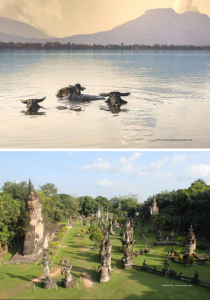
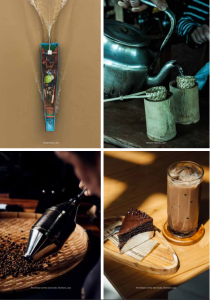
VAT PHOU
The final recommended destination in our tour of Laos lies in the deep south of the country. Vat Phou is a remarkably well-preserved Khmer Hindu temple complex that is more than 1,000 years old. It is one of the oldest places of worship in Southeast Asia, and was a part of the Khmer Empire centred on Angkor. The site was designated as a UNESCO World Heritage Site in 2001. It is accessible as a day trip from the nearby city of Pakse, which is one of the few Laotian cities with an international airport.
Vat Phou is divided into six terraces on three levels joined by a frangipani-lined stairway ascending the Phou Kao Mountain to the main shrine at the top. At the lower level, you will first encounter the large sandstone base of the ancient main entrance to Vat Phou. Here, you will see a ceremonial promenade lined with stone lotus buds and flanked by two small barays (an artificial body of water) filled with lotus flowers.
The middle level features two quadrangular pavilions built of sandstone and laterite that were believed to date from mid10th to early-11th century. Other structures of note at this level include the Nandi Hall and a very impressive dvarapala (gate guardian) stone sculpture. At the upper level, you will see the sanctuary itself, which contains a set of ancient Buddha images on an altar as well as many other Buddhist carvings. Sculpted into a large boulder behind the sanctuary is a Khmer-style Trimurti, which is the Hindu holy trinity of Shiva, Vishnu and Brahma. Other notable places and artefacts at this level include a cave from which the holy spring flowed into the sanctuary, and the elephant and crocodile stones.
There is a lot to take in during your time at Vat Phou. After having visited and seen all the different buildings and artefacts in the area, take a moment to just sit down and soak in the magnificent view of your surroundings, including the barays, the plains and the Mekong itself.
Lastly, Vat Phou is actually an active temple, with Buddhist religious ceremonies taking place at the main sanctuary. If you visit Vat Phou on the full moon of the 3rd lunar month, you will see locals celebrating Makha Bucha Day. The festival takes place for three days, with events ranging from offerings and monk-blessing ceremonies to games, and traditional dance and music performances.
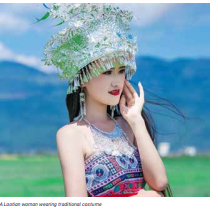
DISCOVER LAOS
If you are in the mood for some short distance travel within the region, but do not want to tread the oft-travelled paths to Malaysia, Thailand or Vietnam, Laos offers a good alternative that is different and refreshing. Despite many of us knowing about Laos, most of us have never actually visited the country. You may want to consider flying to this little-visited neighbour for your next holiday. There could be plenty of great and wonderful surprises in store for you as you discover Laos.










